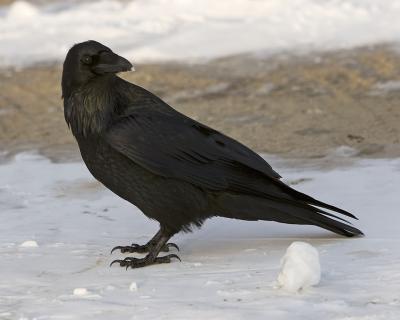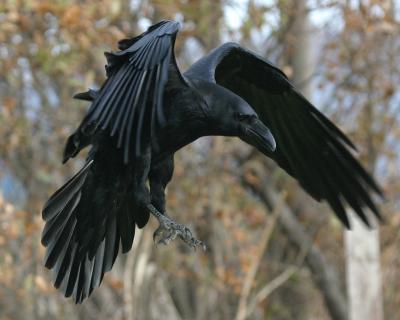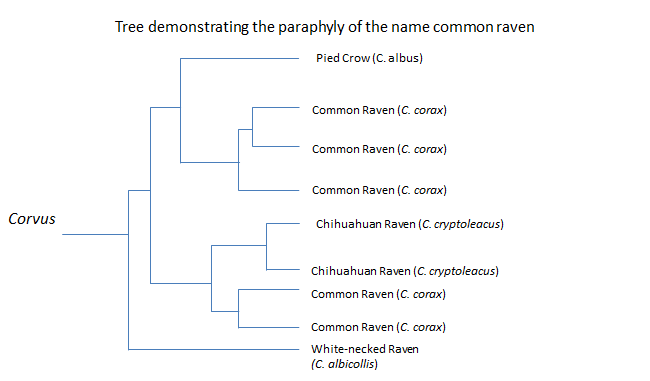Classification
Domain- Eukarya
Kingdom- Animalia
Phylum- Chordata
Class- Aves
Order- Passeriformes
Family-Corvidae
Genus-Corvus
Species-Corvus corax
Below are morphological descriptions confirming why Corvus corax belongs in each taxonomic group.

Domain Eukarya
The common raven belongs to this domain because it has a true nucleus (nuclear envelope) and membrane bound organelles (Campbell 2008).
Members of this kingdom are multicellular heterotrophs which have tissues that develop from embryonic layers (Campbell 2008).
Phylum Chordata
All members of this phylum including the common raven at some point in development have a notochord, dorsal hollow nerve chord, pharyngeal slits or clefts and a muscular tail that protrudes past the anus (Campbell 2008).
The phylogenetic tree below shows how Coruvs corax (Class Ave) is related to other animals and chordates.
The common raven belongs to this class for a number of reasons. Corvus corax has feathers, a beak with no teeth, it lays eggs with hard outer shells, it is bipedal, and has a four chambered heart with a lightweight but strong endoskeleton (Encyclopedia of Life 2012).
Like the common raven, this order includes “perching birds”. They have a foot with three toes forward and one behind. Covering the surface of their feet these birds have rough, coarse, and bumpy skin that enables them to perch on large and small branches in all different kinds of weather (Encyclopedia of Life 2012).
Family Corvidae
Members of this family are large to very large in size; they have nostrils covered by bristle like feathers, as well as strong beaks and large wingspans. Both sexes of this family are similar in color and size, and generally molt only once a year (Encyclopedia of Life 2012).
Genus Corvus
There is no particular morphological synapomorphy that supports why the common raven is classified within this genus. Most members of this genus are black in color, but using the color of feathers as a morphological classification is not particularly valid. Members of the genus Corvus, although mostly black, may vary in color from black to brown depending on habitat and location (Encyclopedia of Life 2012).
To understand why the common raven belongs to this particular genus we must look to molecular science for the answer. Scientists have classified this genus based on geographical distribution and molecular data. In recent studies, scientists were able to describe two different mitochondrial lineages of this bird. The two lineages have been called the Holarctic clade and the California clade. The Holarctic clade includes common ravens found throughout Europe, Asia, and most of North America and the California clade represents the lineage of this bird found in the southwest United States. Scientists concluded that there are two different lineages of the common raven after analyzing strands of DNA from multiple birds around the world. With this data there is a confirmation of the hypothesis that the common raven is a paraphyletic group (Feldman 2005).There is a restricted gene flow between these two lineages and researchers believe that we may be underestimating the true scope of what the genus Corvus and even the species Corvus corax represents. Could the classification of Corvus corax be multiple species described simply as one type of organism, or is there more birds of the genus Corvus that need to be included in this species? Only more research can answer that question, an endeavor that has yet to be concluded.
Below is a phylogenetic tree that depicts the data deduced from the experiment mentioned above.
Go to Habitat to see where the common raven lives and can be found!
Back to Top
Back to Homepage





